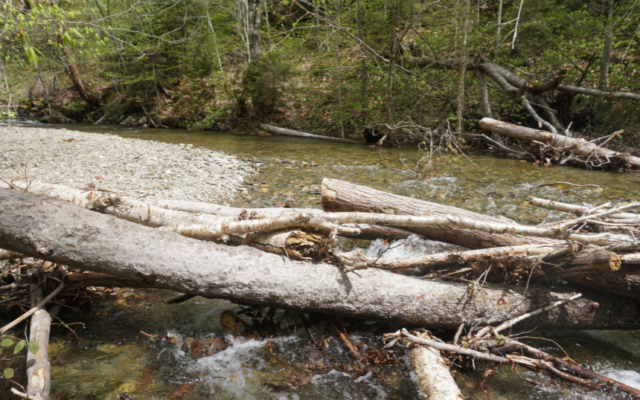
Work on Maine streams could mean more brook trout
Better habitat in Maine streams may lead to a substantial increase in the number of brook trout living there after Trout Unlimited completes projects that will be funded by a nearly $1.8 million grant.
The federal grant from the Natural Resource Conservation Service will also help fund several projects on streams in New Hampshire and Vermont over the next four years.
A key component of that work, according to Jeff Reardon, TU’s Maine Brook Trout Program Coordinator, involves cutting down large trees and putting them in trout streams, which will help make those waters more productive in a number of ways. He expects contracts to be signed this summer, and the bulk of the work to take place between 2021 and 2023.
“The big picture concept is if you came to Maine in 1600, or even 1700, you would have had mature forests standing next to all of our streams. And when the trees grew big enough that a hurricane or an ice storm knocked them down, they’d fall into the streams and they would become part of the physical habitat in the stream,” Reardon said.
Those trees, some three or four feet in diameter would change the streambed. A single large tree lying in the water could help form a pool a few feet deep where only a six-inch-deep trickle had existed before. Insects like caddis flies, mayflies and stoneflies would grow on those trees. And the flow of the streams would slow down in places, allowing fish to live in the resulting pools.
Reardon explained that logging operations have since removed many of those large trees from the sides of streams. Log-driving efforts often called for bulldozing or dynamiting those same streams so that logs could be floated to mills. And all of that has led to less productive habitat.
“If we wait for Mother Nature to replace [this habitat], we’re talking about a timescale of thousands of years,” Reardon said. “So [these projects are] going in very deliberately and saying, ‘Okay, here’s what we’ve got for a stream channel. Here’s what we’ve got for trees.’ There are some calculations as to you know, how many pieces of what size wood is appropriate for what size stream.”
And over the next four years, TU plans to add large wood to streams over 25 miles in each of the three states.
Reardon said the projects wouldn’t be possible without the help of others, and he looks forward to forming more alliances in the future.
“Here in Maine, the two partners who went in with us on the application were Appalachian Mountain Club and Project Share. So we know we’re going to be working for them,” Reardon said. “But this is also a program that any eligible landowner can apply to through their local NRCS office.”
New Hampshire and Vermont have been utilizing the technique for some time, and Jud Kratzer of the Vermont Fish and Wildlife Department has studied the effect of those efforts in his state.
“[One paper from 2018] looked at how brook trout populations responded to strategic additions of wood in streams, comparing paired stream segments where wood was added to untreated streams,” Reardon said. “They found that brook trout biomass tripled at treated sites, while it actually declined slightly in untreated sites over the same time.”